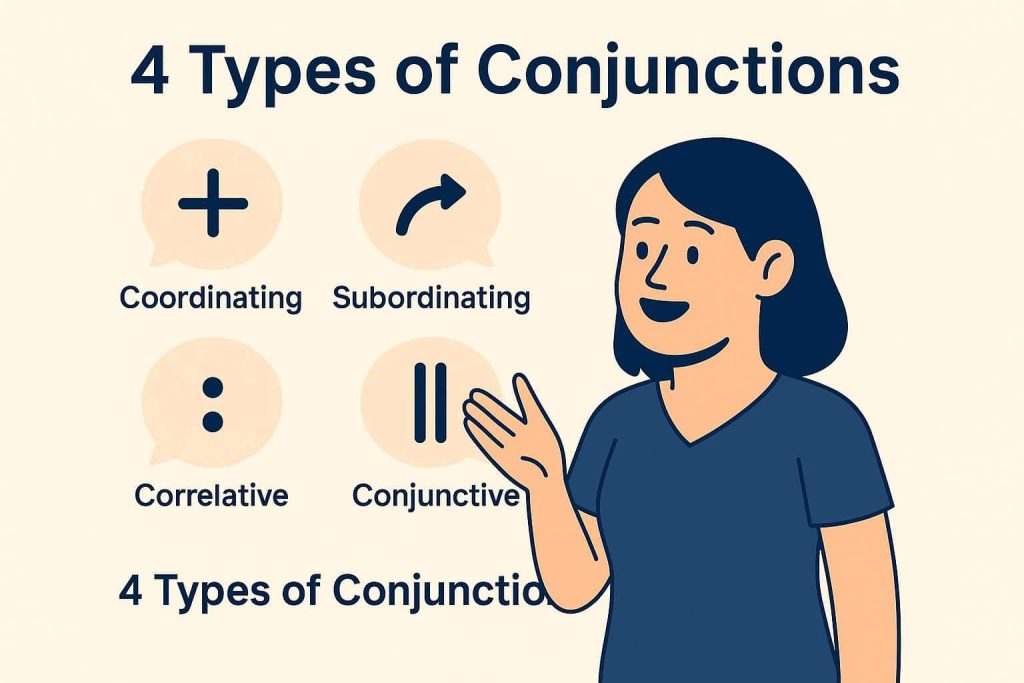If you’re just starting to learn English grammar, you might find words like “and,” “but,” or “because” confusing. These words are called conjunctions, and they help connect ideas, sentences, and even paragraphs. Learning about conjunctions is an important step in understanding English grammar. In this article, we’ll look at the four main types of conjunctions, give lots of examples, explain the rules, point out common mistakes, and share helpful tips—all in clear, simple language for beginners.
What Are Conjunctions?
A conjunction is a word that joins words, phrases, or clauses. You can think of conjunctions as bridges that make your sentences flow better. Without them, speaking and writing would sound broken and disconnected.
Why Are Conjunctions Important?
Conjunctions help you express more complex ideas, show how thoughts are connected, and make your communication clearer. Learning to use conjunctions well is an important part of improving your English grammar.
The 4 Types of Conjunctions
There are four main types of conjunctions in English:
- Coordinating Conjunctions
- Subordinating Conjunctions
- Correlative Conjunctions
- Conjunctive Adverbs
Now let’s look at each type with simple explanations and lots of examples.
1. Coordinating Conjunctions
Coordinating conjunctions connect words, phrases, or independent clauses that have equal importance. The most common ones are:
- For
- And
- Nor
- But
- Or
- Yet
- So
You can remember them with the acronym FANBOYS.
Examples of Coordinating Conjunctions
- I want tea and coffee.
- She tried hard, but she didn’t win.
- You can have cake or ice cream.
Grammar Rules
- Use a comma before a coordinating conjunction when joining two independent clauses.
- Example: I was tired, so I went to bed early.
- No cYou don’t need a comma when you join single words or short phrases.ample: Apples and oranges are healthy.
Common Mistakes
- Forgetting the comma in compound sentences.
- Incorrect: I finished my homework but I forgot to bring it.
- Correct: I finished my homework, but I forgot to bring it.
2. Subordinating Conjunctions
Subordinating conjunctions connect an independent clause with a dependent clause. They show relationships like cause, time, contrast, and condition.
Common subordinating conjunctions include:
- Because
- Although
- Since
- If
- When
- While
- Unless
- After
- Before
Examples of Subordinating Conjunctions
- Because it was raining, we stayed indoors.
- She will call you when she arrives.
- I can’t go out unless I finish my work.
Grammar Rules
- If the dependent clause comes first, use a comma after it.
- Example: Although it was late, he kept working.
- No comma if the independent clause comes first.
- Example: He kept working although it was late.
Common Mistakes
- Some people put a comma before the subordinating conjunction in the middle of a sentence, but this is incorrect.
- Incorrect: I will go, if I finish early.
- Correct: I will go if I finish early.
3. Correlative Conjunctions
Correlative conjunctions come in pairs and join words or groups of words that are equally important in a sentence.
Common pairs are:
- Both … and
- Either … or
- Neither … nor
- Not only … but also
- Whether … or
Examples of Correlative Conjunctions
- Both my brother and my sister are doctors.
- You can either come with us or stay home.
- Not only did he win, but also broke the record.
Grammar Rules
- Make sure each part of the pair matches grammatically (parallel structure).
- Example: She likes not only swimming but also running. (Both gerunds)
Common Mistakes
- A common mistake is mixing up the structure of the sentence.
- Incorrect: She likes not only to swim but also running.
- Correct: She likes not only swimming but also running.
4. Conjunctive Adverbs
Conjunctive adverbs connect two independent clauses and show relationships like contrast, cause, or sequence. They work like conjunctions, but they are actually adverbs.
Common conjunctive adverbs include:
- However
- Therefore
- Moreover
- Consequently
- Meanwhile
- Otherwise
- Furthermore
Examples of Conjunctive Adverbs
- She was tired; however, she finished her work.
- The test was difficult; therefore, many students failed.
- He studied hard; consequently, he passed the exam.
Grammar Rules
- When you connect two independent clauses with a conjunctive adverb, use a semicolon before it and a comma after it.
- Example: It was cold; however, we went outside.
Common Mistakes
- A common mistake is using a comma instead of a semicolon before the conjunctive adverb.
- Incorrect: It was cold, however, we went outside.
- Correct: It was cold; however, we went outside.
Tips for Mastering Conjunctions
- Practice by writing your own sentences with each type of conjunction.
- Check your punctuation: Pay attention to commas and semicolons, especially with coordinating conjunctions and conjunctive adverbs.
- Read and listen: Notice how native speakers use conjunctions in books, movies, and conversations.
- Review grammar basics: Understanding the roles of clauses will help you use conjunctions correctly.
Common Mistakes and How to Avoid Them
- Run-on sentences: Don’t just join sentences with “and” or “but” without the correct punctuation.
- Misusing pairs: Always use both parts of correlative conjunctions.
- Wrong connector: Use the conjunction that best fits the relationship between ideas.
Conclusion
Conjunctions are small but mighty words that help you link ideas, show relationships, and create smoother sentences. Remember the four types—coordinating, subordinating, correlative, and conjunctive adverbs—and practice using them in your writing. With the tips, rules, and examples shared in this guide, you’ll be well on your way to mastering conjunctions and improving your English grammar basics. Keep reading, practicing, and soon you’ll find conjunctions become second nature in your speech and writing!

Leave a Reply